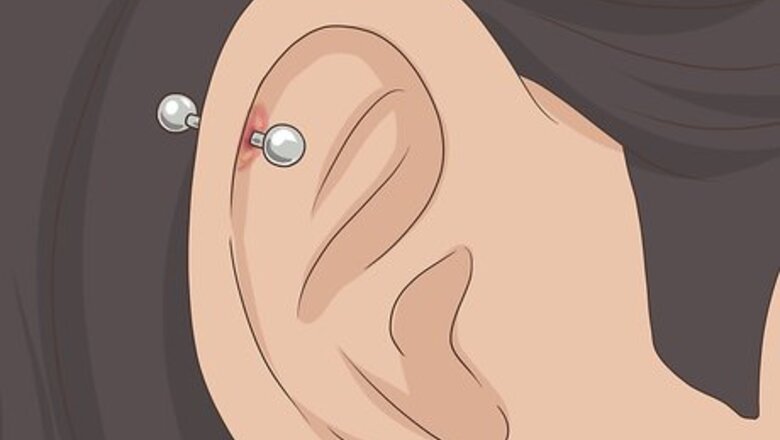
views
X
Trustworthy Source
National Health Service (UK)
Public healthcare system of the UK
Go to source
Caring for Your Piercing at Home
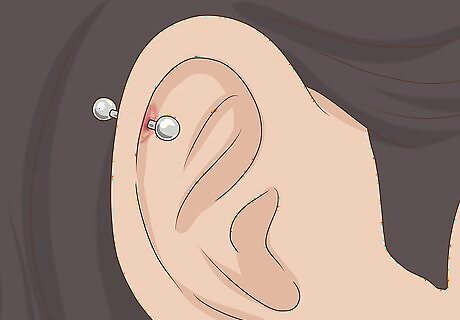
Find and eliminate the source of irritation. According to Dermatologist Navid Malakouti, "Pain, redness, swelling, and warmth [may] be present as a result of the piercing within the first 24 hours, but this does not [necessarily] mean [the piercing] is infected." He adds that infection may be the culprit "if symptoms persist for more than 48 hours after piercing.". If you still notice a bump after this initial piercing period, explore sources of irritation, as piercing bumps happen when something is irritating your skin. If you don't get rid of that irritant, it's likely the bump will return even after you treat it. Common sources of irritation include: Poor quality jewelry. Trauma to the piercing site (playing with, pulling, or pressing on your piercing). Improper aftercare. The angle of your piercing.
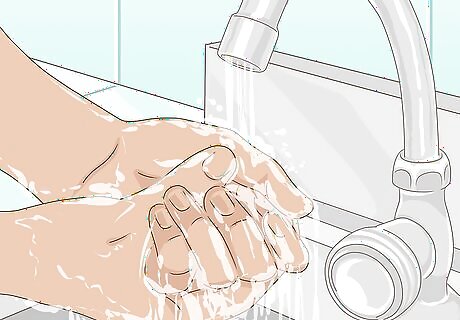
Wash your hands before touching your ears. Use a mild soap and warm water to carefully wash your hands. You want to make sure your hands don't introduce any bacteria into your piercing. If you have hair that falls down over your ears, you may want to keep it pulled back while the piercing is healing, just to prevent your hair from potentially contaminating the piercing site.
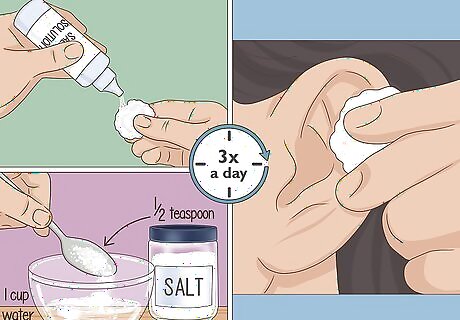
Soak the piercing in a saline or saltwater solution 3 times a day. You might've gotten some saline solution when you got your piercing done. If you didn't, you can pick some up at your local pharmacy or discount store. Dip a cotton ball in the saline and hold it against the piercing to soak it. Make sure you get both sides of the piercing. If you don't have any saline solution, you can make your own. Put about a half teaspoon of salt in about 1 cup (0.24 liters) of water, then stir until the salt has dissolved. Hold the cotton ball with the saline directly on the bump for a few minutes to help it soak into the skin and penetrate the bump to loosen up the fluid.
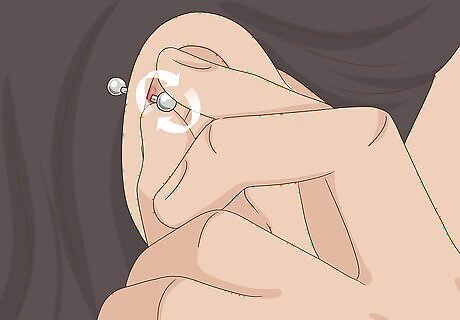
Turn your piercing a few times to keep it from sticking in the hole. Turn the piercing slowly and carefully. If any pus or crusty material comes out of the piercing, dab it with the cotton ball to clear it away from the piercing. Don't pull at the piercing or play with it — you could cause additional trauma to the piercing site.
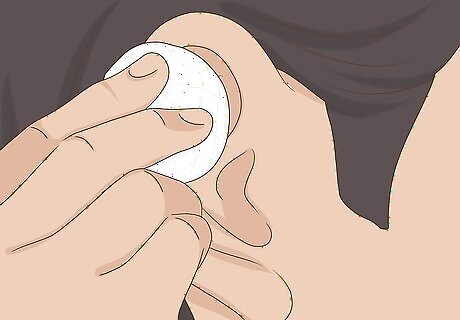
Pat the piercing site dry with sterile gauze or a clean tissue. After you've finished cleaning, dry the piercing. Avoid touching it again after it's dry. Look for any changes around the piercing since you last cleaned it. If the piercing site is red or swollen, or if it's painful for you to clean it, have a reputable piercer or healthcare professional look at it.
Seeking Medical Help

Get immediate treatment if you develop a fever of over 100 °F (38 °C). A fever is an indication of a more serious infection and means you should call your doctor as soon as possible. If it's after-hours when the fever starts, go to an urgent care clinic. If the infection doesn't improve after you've been caring for it for 48 hours, or gets worse, you should also seek emergency medical care. It might turn out to be nothing, but it's better to be safe.

Have a reputable piercer look at the angle of your piercing. If you were pierced with quality jewelry, haven't had any trauma to your ear, and cared for your piercing properly afterward, your ear may have been pierced at the wrong angle. If you don't want to go back to the original piercer, look for a piercer near you who is a member of the Association of Professional Piercers (APP). Go to https://safepiercing.org/ and click on "Find a Member" to find an APP member near you.
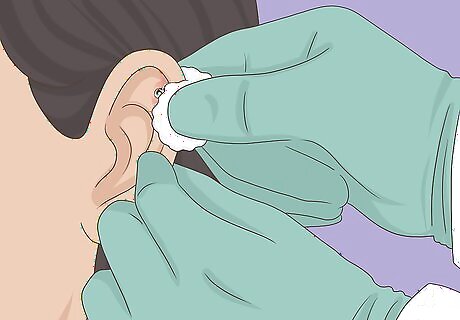
Visit your doctor if your cartilage is painful or swollen. According to Dermatologist Navid Malakouti, "Minor infections can be treated with prescription or nonprescription antibacterial ointments. More severe infections may require prescription oral antibiotics." A cartilage infection is a bit more serious than a soft tissue infection and might require prescription antibiotics. Your doctor can assess the condition of your ear and decide how best to proceed. Don't remove the piercing before you see your doctor. It could cause infection to spread. If your doctor prescribes a round of antibiotics, take the full round, even if your ear starts to feel better. If you stop taking antibiotics early, your infection could return.
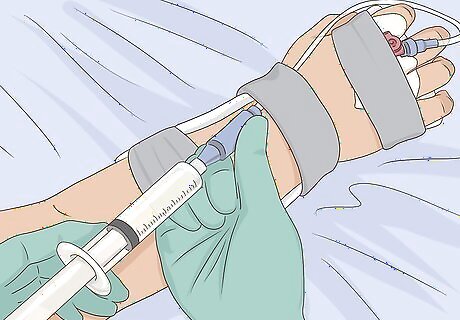
Take intravenous antibiotics if necessary to clear the infection. In the worst-case scenario for a cartilage infection, oral antibiotics won't be able to get to the source of infection quickly enough to kill the infection before you seriously injure your ear. For infections this severe, you would be admitted to the hospital and given intravenous antibiotics. This level of infection is relatively rare with ear piercings, especially if you have a reputable piercer or healthcare professional look at it as soon as you notice signs of possible infection. Your ear may become infected again if you have an allergy to the jewelry’s material. According to Dermatologist Navid Malakouti, it's common to be allergic to nickel, which can be sneaky because "nickel is found in metals such as stainless steel, silver, white gold, and 14k yellow gold." In the most severe cases, surgery would be necessary to repair damaged ear cartilage.
Preventing Cartilage Bumps
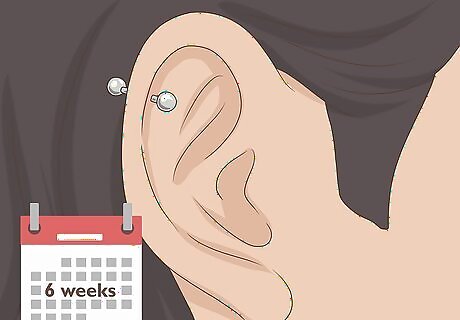
Leave the piercing jewelry in for at least 6 weeks. Generally, it will take about 6 weeks for the channel of your piercing to heal completely so that you can take out the piercing jewelry and wear different jewelry. Cartilage piercings may take longer, depending on the thickness of the cartilage. If your piercer gives you a longer time to keep the piercing jewelry in, follow their instructions. Taking it out too soon could cause trauma to the piercing and lead to bumps or infection. For rashes caused by a new piercing or piece of jewelry, it should clear up in 1-2 weeks if you take care of your skin.
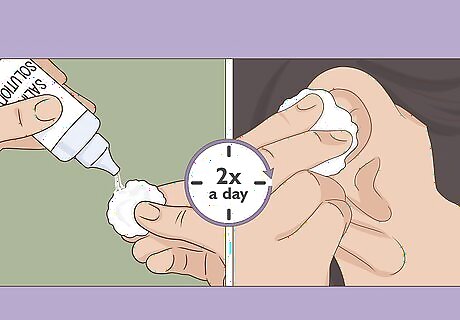
Use saline solution to clean your piercing twice a day. You may have gotten a bottle of saline solution when you got your piercing. Otherwise, you can buy it at your local pharmacy or discount store. Wash your hands, then soak a cotton ball with the saline solution and dab the front and back of the piercing site to thoroughly soak it. After cleaning the piercing site, turn the piercing jewelry 3 or 4 times to keep it from getting stuck, then dab the piercing dry with sterile gauze or a tissue. Follow any additional aftercare instructions your piercer provides you. Your piercer may sell a particular brand of saline solution, but that doesn't mean that's the only brand you can use. Any saline solution will effectively clean your piercing.
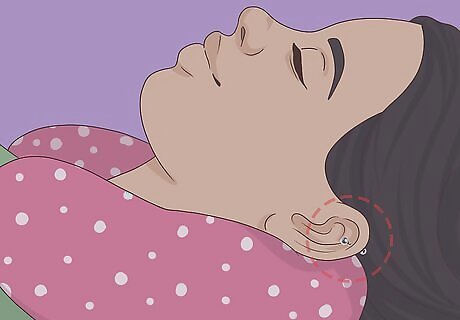
Sleep with an airplane or travel pillow while the piercing is healing. If you sleep on a piercing, you're pressing on the piercing site, which can cause trauma and lead to bumps. Using a travel pillow keeps the weight of your head from pressing on the piercing site. If you don't have a travel pillow, you can also experiment with rolled towels around your neck or at the top of your head to keep pressure off your ear. After the piercing is healed, take out your jewelry before you go to bed each night so the piercing is exposed to the air.
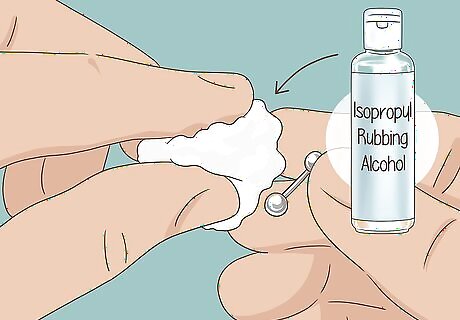
Clean and disinfect jewelry before inserting it. If you want to change the jewelry, wipe it down thoroughly with rubbing alcohol, including the post that goes inside your piercing. Disinfect your piercing with rubbing alcohol as well. Always wash your hands before handling your jewelry and avoid playing with it or touching it except to put it in and take it out.
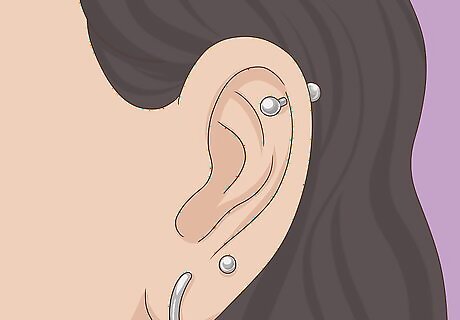
Avoid wearing dangling jewelry while you're active. Dangling jewelry is more likely to snag on something or get pulled while you're playing sports or being active. When jewelry snags and pulls on the piercing, it causes trauma to the ear, which might result in a cartilage bump. You're more likely to get a bump if this happens before your piercing has completely healed. However, it's still a possibility even after you've had the piercing for months.




















Comments
0 comment